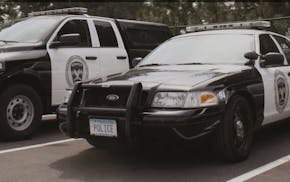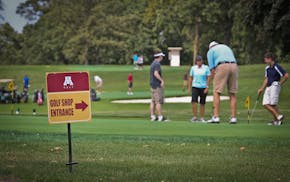Using the torched shell of the former Third Precinct police station as backdrop, Republican U.S. House Speaker Mike Johnson parachuted into Minneapolis last month to taunt Gov. Tim Walz.
"As you can see from the charred and barricaded building right behind us here, four years later, this community still has not recovered," Johnson said.
The derelict building at 3000 Minnehaha Av. remains an eyesore, a painful reminder of the murder of George Floyd by a Third Precinct police officer and a periodic pilgrimage site for conservative pundits in need of a convenient prop for bashing cities.
The city of Minneapolis has been embroiled in years of agonizing negotiations with deeply divided residents over the future of the building and what to do about other sites related to Floyd's murder. The conversations have played out at long evening meetings where neighbors have clashed and city staff of color have absorbed the brunt of hard feelings.
While Mayor Jacob Frey's administration attempts to redevelop key protest sites, segments of the community aren't willing to let the city reclaim control without first demonstrating it understands why the incendiary protests happened.
"No street reconstruction without police reform!" Bobby Hull, who lives a block away from George Floyd Square, demanded at a workshop last week about the intersection's future.
Meanwhile, life is moving forward in south Minneapolis. People are fighting to keep businesses afloat in the historical Black cultural corridor of 38th Street, trying to catch the bus despite the dug-up streets, rebuilding Lake Street lots left vacant by rioting while homeless encampments ricochet through the surrounding neighborhoods, stretching the community's resilience.
New York, Newark, N.J., and other cities have installed permanent memorials to Floyd, but Minneapolis hasn't yet decided how to encapsulate the events of 2020.
Alexander Kado, a Minneapolis senior project manager in charge of George Floyd Square and the former precinct building, said that's because no other city understands what Minneapolis has been through.
"George Floyd was not killed in any of those locations, and so the complexity and the sensitivity and the emotional component of building any type of memorial in a place where that tragedy happened is completely different," he said.
"A lot had to go into doing it in a way that's right, that community supports, and that's why it's taken the time it's taken."
3000 Minnehaha Av.
This spring, City Operations Officer Margaret Anderson Kelliher announced that the former Third Precinct police station would become a "democracy center," incorporating an early vote center, voting machine warehouse and 8,000 square feet reserved for a yet undefined community use.
The decision came after a controversial public engagement campaign last yearfailed to render a plan.
Simultaneously, city staff hinted that cosmetic improvements would soon appear at 3000 Minnehaha Avenue, including the removal of razor wire in the spring or summer. Six months later, the wire is still there.
Problems with a contract for soot abatement inside the building set back interior repairs of windows and doors, which still need to be secured before the fencing can be removed, said city spokesman Allen Henry.
Last week, a new group announced plans to develop a "community-sanctioned proposal" for the site. The 3000 Minnehaha Coalition includes the owner of neighboring Moon Palace Books and the executive director of Redesign Inc., which has been restoring the burned Coliseum building as a Black business hub.
"The desire among many neighbors is for this site to become a cultural district that is a destination for entertainment and community life," said Duaba Unenra, cofounder of Confluence, a design studio that has been hosting community meetings on the former precinct.
A voting center isn't relevant to the area's many residents in various stages of immigration, he said, and the idea of warehousing machines there feels "punitive."
The next open house on the project will be at 5:30 p.m. Wednesday at the Minneapolis American Indian Center. City staff are expected to present survey results showing 63% of 900 respondents from across Minneapolis support creation of the democracy center, the sole option provided; 50% said the center would contribute to racial healing.
Community Safety Centers
Displaced Third Precinct officers have been headquartered in downtown Minneapolis for the past few years, but the city's police reform settlement with the Minnesota Department of Human Rights requires finding them a permanent home.
The $17 million solution? A new South Minneapolis Community Safety Center at 2633 Minnehaha Av. that would open in early 2025 and combine police with community providers of domestic violence, mental health, human trafficking and youth services.
Amanda Harrington, the city's director of Community Safety Design, was hired last December. This spring, her team held 40 in-person meetings with various demographic groups, including people experiencing homelessness.
"We've actually been moving at lightning speed," Harrington said.
She is also trying to launch a temporary Lake Street Community Safety Center by November to address the intense needs of the East Lake Street immigrant business corridor. Riots in 2020 heavily damaged the corridor, and it continues to struggle with gun violence and homelessness.
"I've never seen in my whole life as many young people, 16 and 17 years old, in full-blown addiction to drugs, and the poverty that's just plagued Lake Street for decades is still there," said Jordan Borer Nelson of the Mad Dads violence interrupter group, which has patrolled Lake Street since last summer.
The new center at 2228 E. Lake St. is expected to house a crime prevention specialist, the diversion group Let Everyone Advance with Dignity, opioid prevention services, 311 customer service and Behavioral Crisis Response, the city's mental health first responders.
George Floyd Square
The intersection of 38th and Chicago hasn't changed much from the day Floyd died. While traffic now moves freely through the intersection, it's still piled high with protest art.
The city is determined to upgrade the aging street, find a developer to transform the "People's Way" protest headquarters for another community-centered purpose and potentially reorganize the sprawling memorials.
Construction isn't expected to begin until as soon as next year, but after two years of community workshops attended by local residents, business owners, artists and activists, the city is finally due to release a plan on Oct. 29.
Willie Frazier of Finish Touch Boutique, one of the few Black business owners left in the square, hasn't participated in recent meetings, he said, because "they're talking about everything but the businesses."
The last workshop of the year was heavily attended by people who passed on the first four. Some showed up in hopes of being heard a final time, others to remind city representatives that George Floyd Square remained a protest zone.
At times, the city's engagement contractor, Anthony Taylor of the Cultural Wellness Center, was visibly frustrated amid disruptions.
"What if there was any confidence that we could start something that could turn into a positive outcome for us, for people who live here now?" he asked.
Ralph Crowder, a filmmaker who grew up near 38th and Chicago, views the city's redevelopment efforts as a way of exerting changes that didn't emerge from the community. But it also pains him to see the intersection's economic fortunes lagging behind that of other corners of south Minneapolis.
"People are tired, people have been having these conversations for years, and the immediate trauma of that kind of tragedy presents a lot of other emotional issues," he said. "There's potential for great work to be done, but I am definitely a proponent of documenting things for current and historical preservation ... so we can keep each other accountable. The whole world is really still watching."
Several workshop participants have expressed concern for the square's art pieces, including Jay Webb's gardens, the Say Their Names Cemetery and Mourning Passage, an expanding list of people killed by police painted in the street.
The city communications department declined to comment about artists' rights, but the creators of public art have rights over pieces of "recognized stature" under the Visual Artists Rights Act.
Sculptor jordan powell-karis, who installed the square's raised fists, said that while city staff have attempted to negotiate with him, he has no reason to remove the pieces unless the demands of the protesters are met.
"Thus far the community has cared for the fists through car crashes and over three years of Minnesota weathering, and a wooden fist replacement can be built in two days if need be," powell-karis said in a statement. "The bottom line is, these weren't built to last forever or be beautiful, they were built to put the power to the people."

Four arrested, no one injured in fighting and shooting following Burnsville High School graduation

One man dead in shooting Friday outside Northtown Mall in Blaine

University of Minnesota is putting its golf course up for sale
Supreme Court allows DOGE team to access Social Security systems with data on millions of Americans
